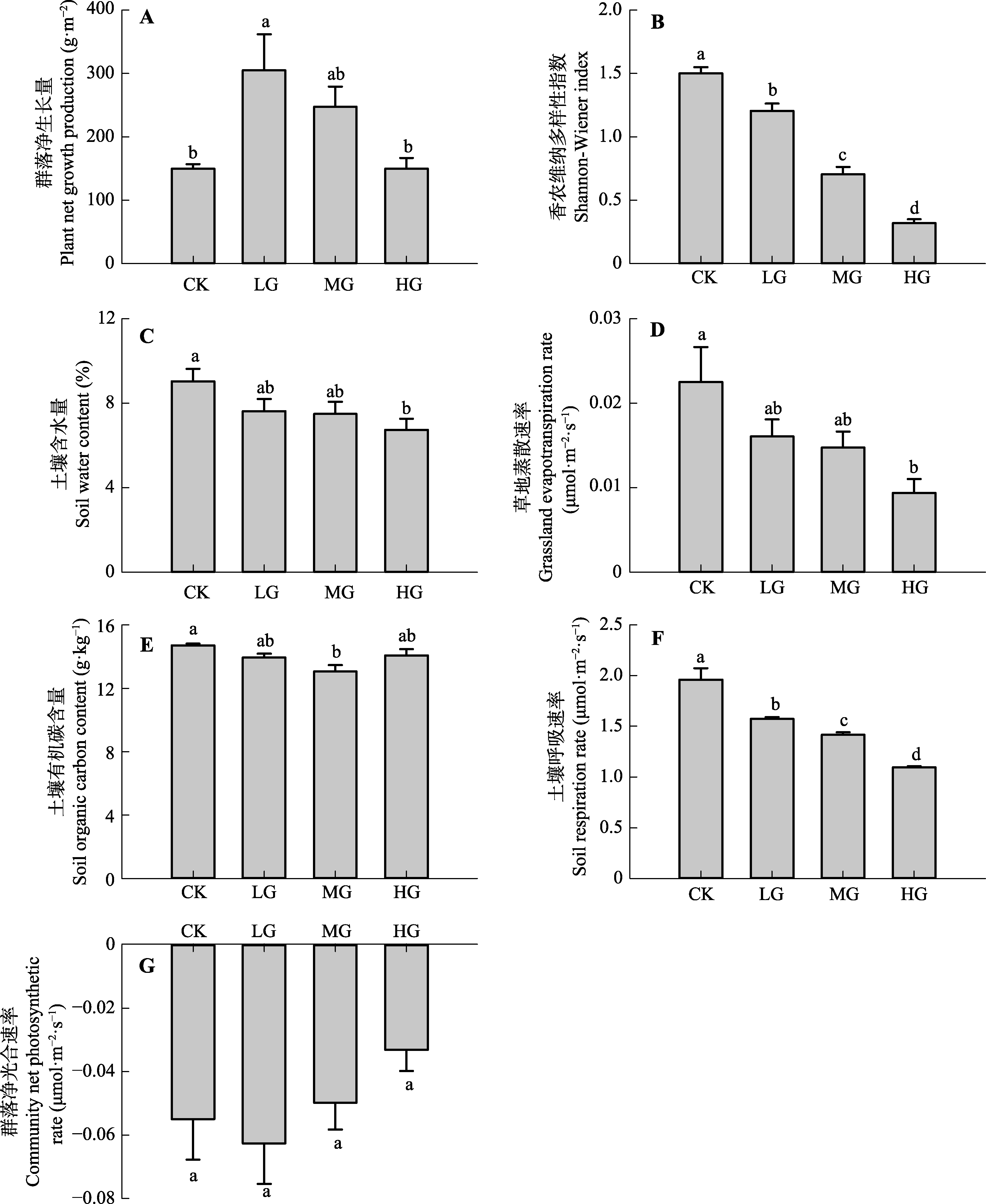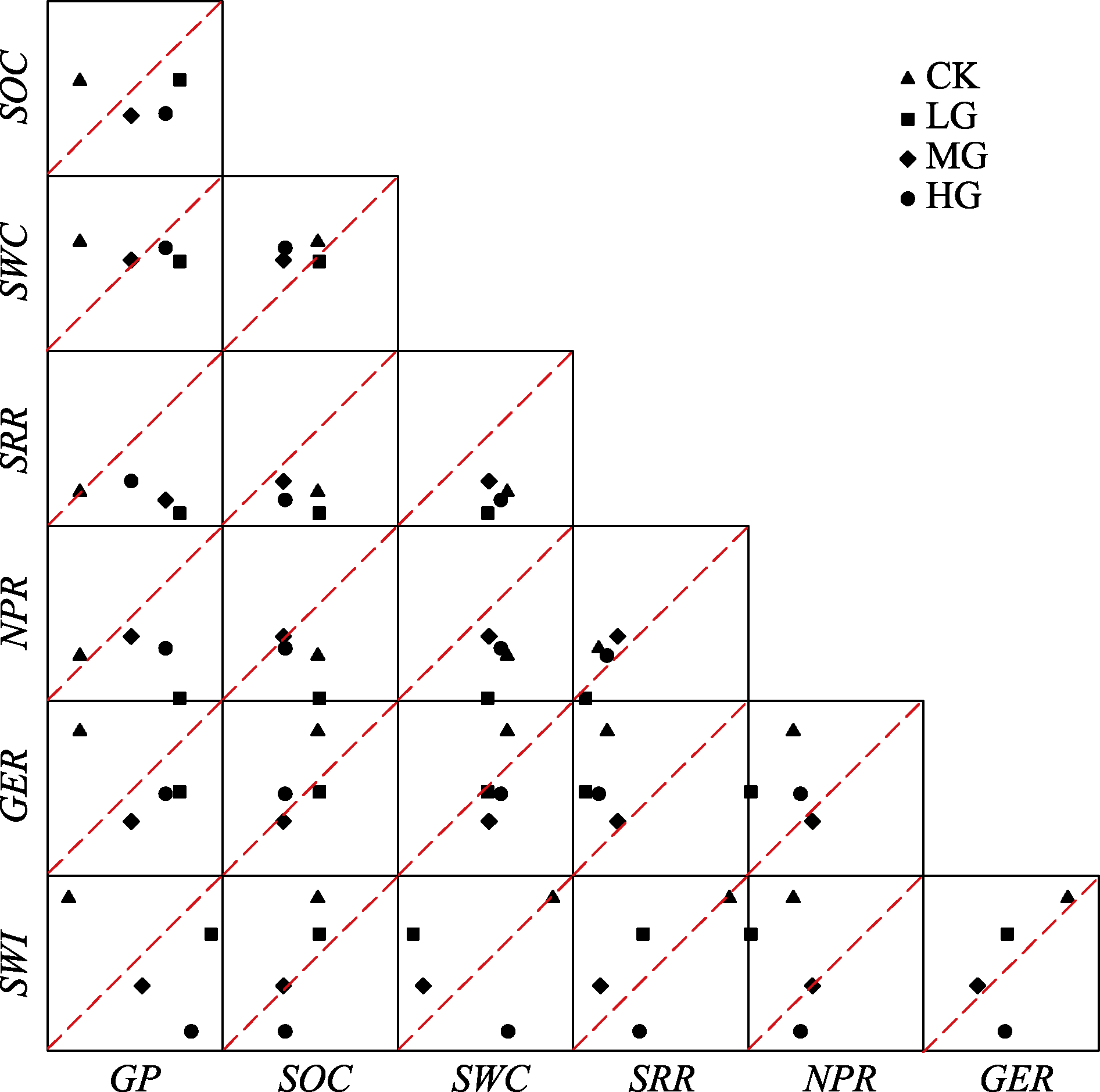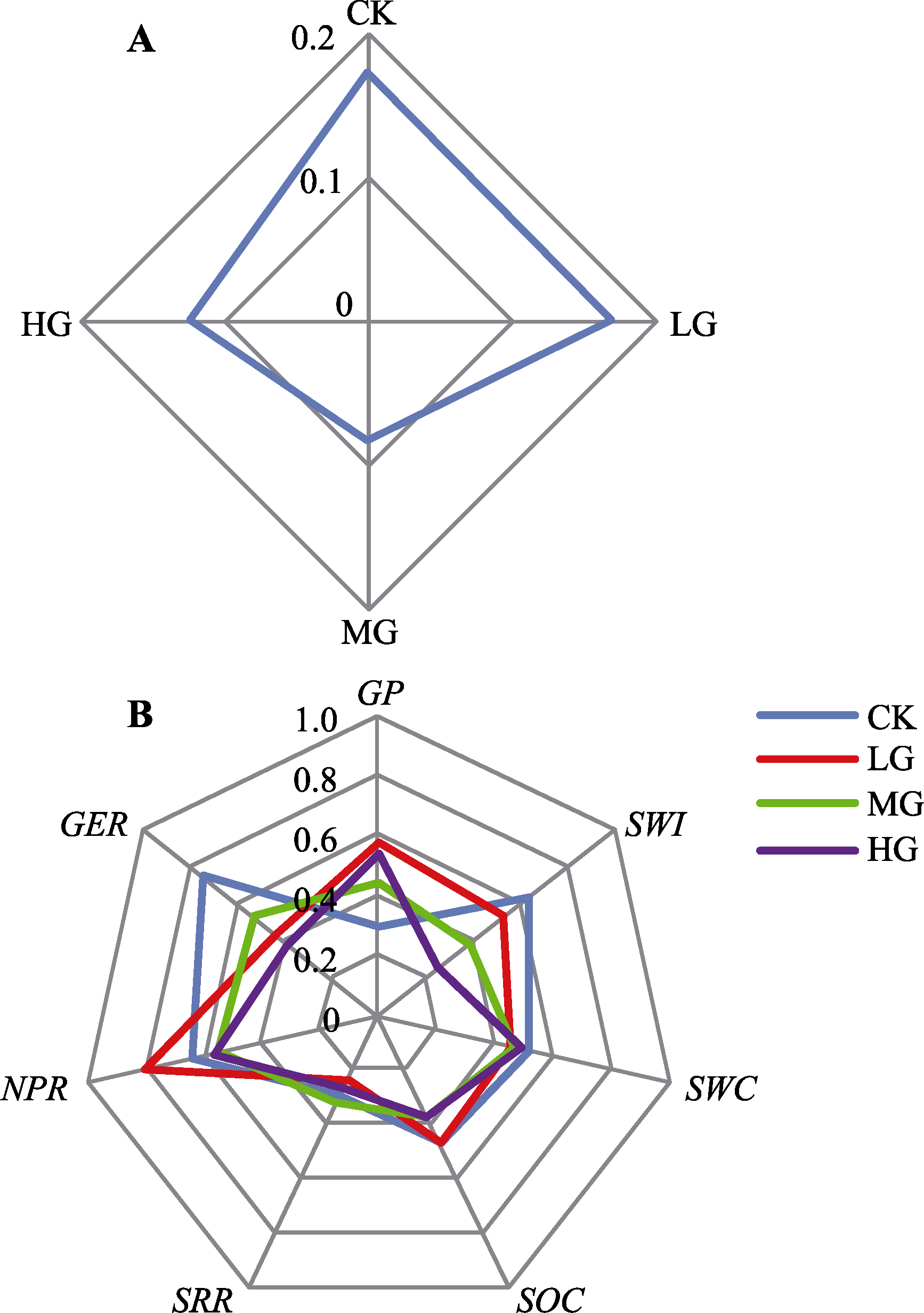

Chin J Plant Ecol ›› 2019, Vol. 43 ›› Issue (5): 408-417.DOI: 10.17521/cjpe.2018.0289
Special Issue: 生态系统结构与功能
• Research Articles • Previous Articles Next Articles
TANG Yong-Kang1,2,WU Yan-Tao1,WU Kui3,GUO Zhi-Wei1,LIANG Cun-Zhu1,*( ),WANG Min-Jie1,CHANG Pei-Jing2
),WANG Min-Jie1,CHANG Pei-Jing2
Received:2020-08-09
Accepted:2019-05-12
Online:2019-05-20
Published:2019-10-18
Contact:
LIANG Cun-Zhu
Supported by:TANG Yong-Kang, WU Yan-Tao, WU Kui, GUO Zhi-Wei, LIANG Cun-Zhu, WANG Min-Jie, CHANG Pei-Jing. Changes in trade-offs of grassland ecosystem services and functions under different grazing intensities[J]. Chin J Plant Ecol, 2019, 43(5): 408-417.
Add to citation manager EndNote|Ris|BibTeX
URL: https://www.plant-ecology.com/EN/10.17521/cjpe.2018.0289

Fig. 3 Variations of the ecosystem services (functions) of the studied grassland under different grazing intensities (mean + SE). The same lowercase letter means no significant different between grazing intensities (p > 0.05). CK, control; LG, light grazing; MG, moderate grazing; HG, heavy grazing.

Fig. 4 Scatter plot matrices of paired ecosystem services (functions) in 2017. CK, control; LG, light grazing; MG, moderate grazing; HG, heavy grazing. GER, grassland evapotranspiration rate; GP, grassland net growth production; NPR, community net photosynthetic rate; SOC, soil organic carbon; SRR, soil respiration rate; SWC, soil water content; SWI, Shannon-Wiener index.

Fig. 5 Radar plots of trade-offs among multi-ecosystem services (functions)(A) and Radar plots of the ES values (B) of multi-ecosystem services (functions) for the studied grassland under grazing gradients. CK, control; LG, light grazing; MG, moderate grazing; HG, heavy grazing. GER, grassland evapotranspiration rate; GP, grassland net growth production; NPR, community net photosynthetic rate; SOC, soil organic carbon; SRR, soil respiration rate; SWC, soil water content; SWI, Shannon-Wiener index.
| 1 | Austin AT (2002). Differential effects of precipitation on production and decomposition along a rainfall gradient in Hawaii. Ecology, 83, 328-338. |
| 2 | Austrheim G, Speed JDM, Evju M, Holand AHO, Loe LE, Martinsen V, Mobak R, Mulder J, Steen H, Thompson DBA, Mysterud A (2016). Synergies and trade-offs between ecosystem services in an alpine ecosystem grazed by sheep—An experimental approach. Basic and Applied Ecology, 17, 596-608. |
| 3 | Bai YF, Huang JH, Zheng SX, Pan QM, Zhang LX, Zhou HK, Xu HL, Li YL, Ma J (2014). Drivers and regulating mechanisms of grassland and desert ecosystem services. Chinese Journal of Plant Ecology, 38, 93-102. |
| [ 白永飞, 黄建辉, 郑淑霞, 潘庆民, 张丽霞, 周华坤, 徐海量, 李玉霖, 马健 (2014). 草地和荒漠生态系统服务功能的形成与调控机制. 植物生态学报, 38, 93-102.] | |
| 4 | Berta ML, Irene IA, Martain Garcia L, Ignacio P, Izaskun CA, David GDA, Erik GB, Elisa OR, Igone PA, Barbara W, Jose AG, Fernando SM, Miren O, Cesar LS, Carlos M (2012). Uncovering ecosystem service bundles through social preferences. PLOS ONE, 7, e38970. DOI: 10.1371/ journal.pone.0038970. |
| 5 | Bradford JB, D’Amato AW (2012). Recognizing trade-offs in multi-objective land management. Frontiers in Ecology and the Environment, 10, 210-216. |
| 6 | Brown K, Adger WN, Tompkins E, Bacon P, Shim D, Young K (2001). Trade-off analysis for marine protected area management. Ecological Economics, 37, 417-434. |
| 7 | Cong WF, Jasper VR, Liesje M, Gerlinde BDD, Frank B, Ellis H (2015). Plant species richness promotes soil carbon and nitrogen stocks in grasslands without legumes. Journal of Ecology, 102, 1163-1170. |
| 8 | Cui XY, Chen SQ, Chen ZZ (2000). CO2 release from typical Stipa grandis grassland soil. Chinese Journal of Applied Ecology, 11, 390-394. |
| [ 崔骁勇, 陈四清, 陈佐忠 (2000). 大针茅典型草原土壤CO2排放规律的研究. 应用生态学报, 11, 390-394.] | |
| 9 | Dang CL (1998). Redundancy structure in phytocoenosiums as an explanation of ecosystem stability. Acta Ecologica Sinica, 18, 665-672. |
| [ 党承林 (1998). 植物群落的冗余结构——对生态系统稳定性的一种解释. 生态学报, 18, 665-672.] | |
| 10 | Davidson KE, Fowler MS, Skov MW, Doerr SH, Beaumont N, Griffin JN, Bennett J (2017). Livestock grazing alters multiple ecosystem properties and services in salt marshes: A meta-analysis. Journal of Applied Ecology, 54, 1365-1401. |
| 11 | Fu BJ, Zhou GY, Bai YF, Song CC, Liu JY, Zhang HY, Lü YH, Zheng H, Xie GD (2009). The main terrestrial ecosystem services and ecological security in China. Advances in Earth Science, 24, 571-576. |
| [ 傅伯杰, 周国逸, 白永飞, 宋长春, 刘纪远, 张惠远, 吕一河, 郑华, 谢高地 (2009). 中国主要陆地生态系统服务功能与生态安全. 地球科学进展, 24, 571-576.] | |
| 12 | Gervasio P, Jose MP, Martin O, Esteban GJ (2010). Pathways of grazing effects on soil organic carbon and nitrogen. Rangeland Ecology & Managemengt, 63, 109-119. |
| 13 | Han GD, Li B, Wei ZJ, Yang J, Lü X, Li H (1999). Plant compensatory growth in the grazing system of Stipa breviflora desert steppe: I. Plant net productivity. Acta Agrestia Sinica, 7(1), 1-7. |
| [ 韩国栋, 李博, 卫智军, 杨静, 吕雄, 李宏 (1999). 短花针茅草原放牧系统植物补偿性生长的研究: I. 植物净生长量. 草地学报, 7(1), 1-7.] | |
| 14 | He JL, Sun YR (2015). Applying a spatial decision support system to the integrated regional planning of China. Environment and Planning B Planning and Design, 47, 1-16. |
| 15 | Hector A, Bagchi R (2007). Biodiversity and ecosystem multifunctionality. Nature, 448, 188-190. |
| 16 | Joubert L, Pryke JS, Samways MJ (2017). Moderate grazing sustains plant diversity in Afromontane grassland. Applied Vegetation Science, 20, 340-351. |
| 17 | Karjalainen TP, Marttunen M, Sarkki S, Rytkönen AM (2013). Integrating ecosystem services into environmental impact assessment: An analytic-deliberative approach. Environmental Impact Assessment Review, 40, 54-64. |
| 18 | Lauenroth WK, Bradford JB (2006). Ecohydrology and the partitioning AET between transpiration and evaporation in a semiarid steppe. Ecosystems, 9, 756-767. |
| 19 | Li LH, Wang QB, Bai YF, Zhou GS, Xing XR (2000). Soil respiration of a Leymus chinensis grassland stand in the Xilin River Basin as affected by over-grazing and climate. Acta Phytoecologica Sinica, 24, 680-686. |
| [ 李凌浩, 王其兵, 白永飞, 周广胜, 邢雪荣 (2000). 锡林河流域羊草草原群落土壤呼吸及其影响因子的研究. 植物生态学报, 24, 680-686.] | |
| 20 | Li YH (1993). Grazing dynamics of the species diversity in Aneurolepidium chinense steppe and Stipa grandis steppe. Acta Botanica Sinica, 35, 877-884. |
| [ 李永宏 (1993). 放牧影响下羊草草原和大针茅草原植物多样性的变化. 植物学报, 35, 877-884.] | |
| 21 | Liang MW, Liang CZ, Bai X, Miao BL, Wang YS, Bao GR, Wang X (2016). Effects of annual plant functional group on biomass and soil respiration in a grazing community of a typical steppe grassland. Prataculitural Science, 33, 2407-2417. |
| [ 梁茂伟, 梁存柱, 白雪, 苗百岭, 王英舜, 包桂荣, 王譞 (2016). 一年生植物功能群对放牧草原生物量和土壤呼吸的影响. 草业科学, 33, 2407-2417.] | |
| 22 | Liu ZK, Wang SP, Chen ZZ, Wang YF, Han JG (2006). Properties of soil nutrients and plant community after rest grazing in Inner Mongolia steppe, China. Acta Ecologica Sinica, 26, 2048-2056. |
| [ 刘忠宽, 汪诗平, 陈佐忠, 王艳芬, 韩建国 (2006). 不同放牧强度草原休牧后土壤养分和植物群落变化特征. 生态学报, 26, 2048-2056.] | |
| 23 | Lu N, Fu BJ, Jin TT, Chang RY (2014). Trade-off analyses of multiple ecosystem services by plantations along a precipitation gradient across Loess Plateau landscapes. Landscape Ecology, 29, 1697-1708. |
| 24 | Maestre FT, Valladares F, Reynolds JF (2005). Is the change of plant-plant interactions with abiotic stress predictable? A meta-analysis of field results in arid environments. Journal of Ecology, 93, 748-757. |
| 25 | Mcintyre S, Heard M, Martin TG (2003). The relative importance of cattle grazing in subtropical grasslands: Does it reduce or enhance plant biodiversity? Journal of Applied Ecology, 40, 445-457. |
| 26 | Millennium Ecosystem Assessment (2005). Ecosystem and Human Well-being. Island Press, Washington DC. |
| 27 | Naidoo R, Balmford A, Costanza R, Fisher B, Green RE, Lehner B, Malcolm TR, Ricketts TH (2008). Global mapping of ecosystem services and conservation priorities. Proceedings of the National Academy of Sciences of the United States of America, 105, 9495-9500. |
| 28 | Nie ZN, Chapman DF, Tharmaraj J, Clements R (2004). Effects of pasture species mixture, management, and environment on the productivity and persistence of dairy pastures in south-west Victoria. 1. Herbage accumulation and seasonal growth pattern. Australian Journal of Agricultural Research, 55, 625-636. |
| 29 | Odum E (1971). Fundamentals of Ecology. Philadelphia, Saunders. |
| 30 | Olff H, Ritchie ME, Prins HHT (2002). Global environmental controls of diversity in large herbivores. Nature, 415, 901-904. |
| 31 | Onatibia GR, Reyes MF, Aguiar MR (2017). Fine-scale root community structure and below-ground responses to grazing show independence from above-ground patterns. Journal of Vegetation Science, 28, 1097-1106. |
| 32 | Pan Y, Wu JX, Xu ZR (2014). Analysis of the tradeoffs between provisioning and regulating services from the perspective of varied share of net primary production in an alpine grassland ecosystem. Ecological Complexity, 17, 79-86. |
| 33 | Pan Y, Xu ZR, Wu JX (2013). Spatial differences of the supply of multiple ecosystem services and the environmental and land use factors affecting them. Ecosystem Services, 5, 4-10. |
| 34 | Pucheta E, Bonamici I, Cabido M, Diaz S (2010). Below- ground biomass and productivity of a grazed site and a neighbouring ungrazed exclosure in a grassland in central Argentina. Austral Ecology, 29, 201-208. |
| 35 | Rodríguez JP, Beard Jr TD, Bennett EM, Cumming GS, Cork S, Agard J, Dobson AP, Peterson GD (2006). Trade-offs across space, time, and ecosystem services. Ecology and Society, 11, 28-41. |
| 36 | Su YZ, Zhao HL (2003). Influences of grazing and exclosure on carbon sequestration in degraded sandy grassland, Inner Mongolia, North China. Environmental Science, 24(4), 23-28. |
| [ 苏永中, 赵哈林 (2003). 持续放牧和围封对科尔沁退化沙地草地碳截存的影响. 环境科学, 24(4), 23-28.] | |
| 37 | Tang HP, Xue HL, Fang F (2015). A comparison of measured and calculated net community CO2 exchange: Scaling from leaves to communities. Chinese Journal of Plant Ecology, 39, 924-931. |
| [ 唐海萍, 薛海丽, 房飞 (2015). 叶片和群落尺度净光合速率关系的探讨. 植物生态学报, 39, 924-931.] | |
| 38 | Wang D, Wu GL, Liu Y, Yang Z, Hao HM (2015). Effects of grazing exclusion on CO2 fluxes in a steppe grassland on the Loess Plateau (China). Ecological Engineering, 83, 169-175. |
| 39 | Wang DL, Wang L (2019). A new perspective on the concept of grassland management. Chinese Science Bulletin, 64, 1106-1113. |
| [ 王德利, 王玲 (2019). 草地管理概念的新释义. 科学通报, 64, 1106-1113.] | |
| 40 | Wang JW, Zhang Z, An BL, Yan GZ (2013). Index weights for seabuckthorn plantation ecosystem services evaluation in the soft rock area. Journal of Arid Land Resources and Environment, 27(10), 145-151. |
| [ 王举位, 张征, 安宝利, 闫国振 (2013). 砒砂岩区沙棘人工林生态系统服务功能评价指标权重初探. 干旱区资源与环境, 27(10), 145-151.] | |
| 41 | Wang L, Manuel DB, Wang DL, Forest I, Liu J, Feng C, Liu JS, Zhong ZW, Zhu H, Yuan X, Chang Q, Liu C (2019). Diversifying livestock promotes multidiversity and multifunctionality in managed grasslands. Proceedings of the National Academy of Sciences of the United States of America, 116, 6187-6192. |
| 42 | Wang SP, Li YH, Chen ZZ (1999). The optimal stocking rates on grazing system in Inner Mongolia steppe: I. Based on analysis of liveweight gain per animal and hectare and benefit. Acta Agrestia Sinica, 7(3), 183-191. |
| [ 汪诗平, 李永宏, 陈佐忠 (1999). 内蒙古典型草原草畜系统适宜放牧率的研究:Ⅰ.以绵羊增重及经济效益为管理目标. 草地学报, 7(3), 183-191.] | |
| 43 | Wang XT, Wang W, Liang CZ (2009). Changes in the population spatial distribution pattern of Leymus chinensis in degraded steppe community during restorative succession in Inner Mongolia, China. Chinese Journal of Plant Ecology, 33, 63-70. |
| [ 王鑫厅, 王炜, 梁存柱 (2009). 典型草原退化群落不同恢复演替阶段羊草种群空间格局的比较. 植物生态学报, 33, 63-70.] | |
| 44 | Wang XT, Wang W, Liang CZ, Liu ZL (2015). Interpretation of grassland degradation caused by overgrazing from the perspective of positive interaction. Chinese Science Bulletin, 60, 2794-2799. |
| [ 王鑫厅, 王炜, 梁存柱, 刘钟龄 (2015). 从正相互作用角度诠释过度放牧引起的草原退化. 科学通报, 60, 2794-2799.] | |
| 45 | Wu JX, Zhao Y, Yu CQ, Luo LM, Pan Y (2017). Land management influences trade-offs and the total supply of ecosystem services in alpine grassland in Tibet, China. Journal of Environmental Management, 193, 70-78. |
| 46 | Xu W, Jing X, Ma ZY, He JS (2016). A review on the measurement of ecosystem multifunctionality. Biodiversity Science, 24, 72-84. |
| [ 徐炜, 井新, 马志远, 贺金生 (2016). 生态系统多功能性的测度方法. 生物多样性, 24, 72-84.] | |
| 47 | Xue R, Zheng SX, Bai YF (2010). Impacts of grazing intensity and management regimes on aboveground primary productivity and compensatory growth of grassland ecosystems in Inner Mongolia. Biodiversity Science, 18, 300-311. |
| [ 薛睿, 郑淑霞, 白永飞 (2010). 不同利用方式和载畜率对内蒙古典型草原群落初级生产力和植物补偿性生长的影响. 生物多样性, 18, 300-311.] | |
| 48 |
Yan RR, Wei ZJ, Yun XJ, Chu WB, W Q, Xin XP (2009). Effects of the grazing systems on diurnal variation of photosynthetic characteristic of major plant species of desert steppe. Acta Prataculturae Sinica, 18(5), 160-167.
DOI |
|
[ 闫瑞瑞, 卫智军, 运向军, 褚文彬, 乌仁其其格, 辛晓平 (2009). 放牧制度对短花针茅荒漠草原主要植物种光合特性日变化影响的研究. 草业学报, 18(5), 160-167.]
DOI |
|
| 49 | Yan X, Gong JR, Zhang ZY, Huang YM, An R, Qi Y, Liu M (2013). Responses of photosynthetic characteristics of Stipa baicalensis to grazing disturbance. Chinese Journal of Plant Ecology, 37, 530-541. |
| [ 晏欣, 龚吉蕊, 张梓瑜, 黄永梅, 安然, 祁瑜, 刘敏 (2013). 狼针草光合特性对放牧干扰的响应. 植物生态学报, 37, 530-541.] | |
| 50 | Yang J, Chu PF, Chen DM, Wang MJ, Bai YF (2014). Mechanisms underlying the impacts of grazing on plant α, β and γ diversity in a typical steppe of the Inner Mongolia grassland. Chinese Journal of Plant Ecology, 38, 188-200. |
| [ 杨婧, 褚鹏飞, 陈迪马, 王明玖, 白永飞 (2014). 放牧对内蒙古典型草原α、β和γ多样性的影响机制. 植物生态学报, 38, 188-200.] | |
| 51 | Zavaleta ES, Pasari JR, Hulvey KB, Tilman GD (2010). Sustaining multiple ecosystem functions in grassland communities requires higher biodiversity. Proceedings of the National Academy of Sciences of the United States of America, 107, 1443-1446. |
| [1] | SACHURA , ZHANG Xia, ZHU Lin, KANG Saruul. Leaf anatomical changes of Cleistogenes songorica under long-term grazing with different intensities in a desert steppe [J]. Chin J Plant Ecol, 2024, 48(3): 331-340. |
| [2] | RU Ya-Qian, XUE Jian-Guo, GE Ping, LI Yu-Lin, LI Dong-Xu, HAN Peng, YANG Tian-Run, CHU Wei, CHEN Zhang, ZHANG Xiao-Lin, LI Ang, HUANG Jian-Hui. Ecological and economic effects of intensive rotational grazing in a typical steppe [J]. Chin J Plant Ecol, 2024, 48(2): 171-179. |
| [3] | LÜ Zi-Li, LIU Bin, CHANG Feng, MA Zi-Jing, CAO Qiu-Mei. Relationship between plant functional diversity and ecosystem multifunctionality in Bayanbulak alpine meadow along an altitude gradient [J]. Chin J Plant Ecol, 2023, 47(6): 822-832. |
| [4] | WANG Xiao-Yue, XU Yi-Xin, LI Chun-Huan, YU Hai-Long, HUANG Ju-Ying. Changes of plant biomass, species diversity, and their influencing factors in a desert steppe of northwestern China under long-term changing precipitation [J]. Chin J Plant Ecol, 2023, 47(4): 479-490. |
| [5] | XI Nian-Xun, ZHANG Yuan-Ye, ZHOU Shu-Rong. Plant-soil feedbacks in community ecology [J]. Chin J Plant Ecol, 2023, 47(2): 170-182. |
| [6] | ZHENG Ning, LI Su-Ying, WANG Xin-Ting, LÜ Shi-Hai, ZHAO Peng-Cheng, ZANG Chen, XU Yu-Long, HE Jing, QIN Wen-Hao, GAO Heng-Rui. Dominance of different plant life forms in the typical steppe evidenced from impacts of environmental factors on chlorophyll [J]. Chin J Plant Ecol, 2022, 46(8): 951-960. |
| [7] | WANG Yi, SUN Jian, YE Chong-Chong, ZENG Tao. Climatic factors drive the aboveground ecosystem functions of alpine grassland via soil microbial biomass nitrogen on the Qingzang Plateau [J]. Chin J Plant Ecol, 2021, 45(5): 434-443. |
| [8] | PAN Quan, ZHENG Hua, WANG Zhi-Heng, WEN Zhi, YANG Yan-Zheng. Effects of plant functional traits on ecosystem services: a review [J]. Chin J Plant Ecol, 2021, 45(10): 1140-1153. |
| [9] | LI Hai-Dong, WU Xin-Wei, XIAO Zhi-Shu. Assembly, ecosystem functions, and stability in species interaction networks [J]. Chin J Plant Ecol, 2021, 45(10): 1049-1063. |
| [10] | JING Xin, HE Jin-Sheng. Relationship between biodiversity, ecosystem multifunctionality and multiserviceability: literature overview and research advances [J]. Chin J Plant Ecol, 2021, 45(10): 1094-1111. |
| [11] | LI Ying, GONG Ji-Rui, LIU Min, HOU Xiang-Yang, DING Yong, YANG Bo, ZHANG Zi-He, WANG Biao, ZHU Chen-Chen. Defense strategies of dominant plants under different grazing intensity in the typical temperate steppe of Nei Mongol, China [J]. Chin J Plant Ecol, 2020, 44(6): 642-653. |
| [12] | ZHANG Yang-Jian, ZHU Jun-Tao, SHEN Ruo-Nan, WANG Li. Research progress on the effects of grazing on grassland ecosystem [J]. Chin J Plant Ecol, 2020, 44(5): 553-564. |
| [13] | XIONG Xing-Shuo, CAI Hong-Yu, LI Yao-Qi, MA Wen-Hong, NIU Ke-Chang, CHEN Di-Ma, LIU Na-Na, SU Xiang-Yan, JING He-Ying, FENG Xiao-Juan, ZENG Hui, WANG Zhi-Heng. Seasonal dynamics of leaf C, N and P stoichiometry in plants of typical steppe in Nei Mongol, China [J]. Chin J Plant Ecol, 2020, 44(11): 1138-1153. |
| [14] | DING Wei,WANG Yu-Bing,XIANG Guan-Hai,CHI Yong-Gang,LU Shun-Bao,ZHENG Shu-Xia. Effects of Caragana microphylla encroachment on community structure and ecosystem function of a typical steppe [J]. Chin J Plant Ecol, 2020, 44(1): 33-43. |
| [15] | WEN Chao,SHAN Yu-Mei,YE Ru-Han,ZHANG Pu-Jin,MU Lan,CHANG Hong,REN Ting-Ting,CHEN Shi-Ping,BAI Yong-Fei,HUANG Jian-Hui,SUN Hai-Lian. Effects of nitrogen and water addition on soil respiration in a Nei Mongol desert steppe with different intensities of grazing history [J]. Chin J Plant Ecol, 2020, 44(1): 80-92. |
| Viewed | ||||||
|
Full text |
|
|||||
|
Abstract |
|
|||||
Copyright © 2022 Chinese Journal of Plant Ecology
Tel: 010-62836134, 62836138, E-mail: apes@ibcas.ac.cn, cjpe@ibcas.ac.cn